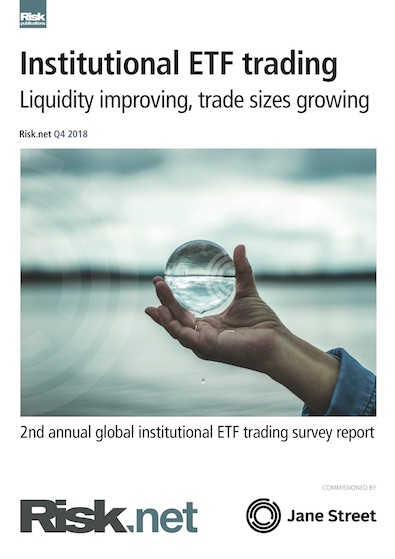[ad_1]

[This ETF Industry Perspective is sponsored by Jane Street.]
As a leading liquidity provider, Jane Street commissioned a survey of nearly 300 global institutions to gauge the dominant trends in the market. The 2018 study found institutional investors are more comfortable with ETF liquidity, and they are growing more confident when it comes to making large trades. With that increasing sophistication comes a shifting of priorities regarding how and with whom they trade ETFs. Here, ETF.com Managing Director Dave Nadig talks with Andrew Upward, ETF strategist with Jane Street, about the implications of the study’s results.
ETF.com: In this latest survey, Jane Street decided to go out and poll a global institutional audience. What was the genesis of the idea?
Andrew Upward: There are a lot of surveys out there on how institutions are using ETFs, but very few—if any—that cover how institutions are trading them. We trade ETFs with institutional investors every day, and we saw an opportunity to shed some light on the trading side of things.
And then part of the motivation was just curiosity. We had strong feelings about what was happening in the marketplace, and we were curious whether it was just us thinking these were some of the trends we were seeing, or are these things actually real? The best way to confirm that was to go out and ask as many of our clients as we possibly could.
ETF.com: What were some of those ideas you wanted to test with institutions?
Upward: First and foremost, the emphasis on competitive pricing definitely seems like a trend, and it’s ultimately a tail wind for our business. We just feel like there’s a lot of competition in the space, whether it’s things like RFQ platforms facilitating competition, or just the ongoing challenge for market makers trying to win trades. We just wanted to verify that, yes, competitive pricing is important to our counterparties, too.
Second, we wanted to understand how institutions are looking at ETF liquidity. And the combination of our findings was striking: We found that nearly 90% of institutions feel that ETFs are more liquid or about the same as three year ago. And this finding wouldn’t be as meaningful if it weren’t accompanied by an increased level of sophistication when it comes to how they most commonly evaluate ETF liquidity—using the liquidity of the underlying securities.
ETF.com: One of the things I found most interesting from the study was the stark difference between Americas-based and European-based institutions. Less than half the American respondents said competitive pricing was the most important thing, but 71% of the Europeans said it was. Is that representing the real difference in the two continents?

Upward: The difference is really striking. And if you looked further down in that bar chart highlighting the European responses, you’ll see 0%—literally one person—saying the most important issue was value-added services like research.
That just speaks to the regulatory spur from the European politicians who said, “Look, ‘best ex’ is about execution, right? And you’re unbundling research from execution.” A European trader ought to be saying that price is the most important thing because that’s one of the core elements of best ex: price. I think that explains the 71% in relation to the numbers that were from the Americas or the Asia-Pacific region.
Having said all that, I’ve been speaking to quite a few asset managers here in the U.S. about unbundling. It might not be a top-down regulatory mandate as it is in Europe, but global asset managers in particular that are based in the U.S. are clearly paying attention to what’s happening across the pond. And they’re getting questions from their end clients about how their commission dollars are being spent. I think that’s why the number of traders primarily focused on competitive pricing is still quite high in the U.S. in particular.
I also think it’s about competition in the asset management industry. We see a structural change in the industry whereby asset managers everywhere in the world are saying, “You know what? Let’s go for best execution and let’s make sure we’re getting the best price and the best execution experience we can get, and we’ll figure out how to pay for research and these other ancillary things that we value separately after the fact.”
[ad_2]
Source link Google News

